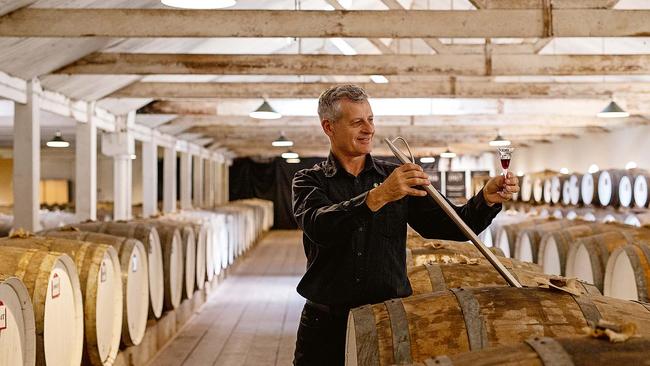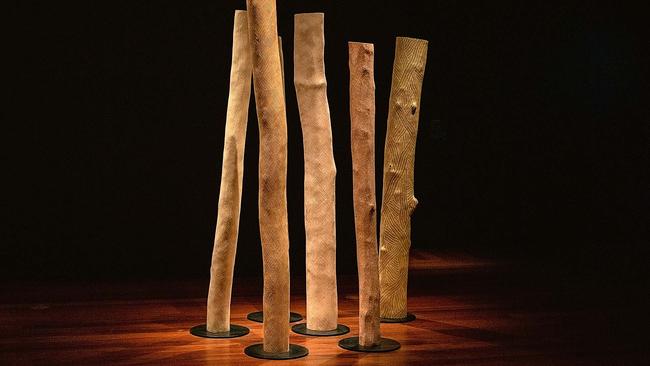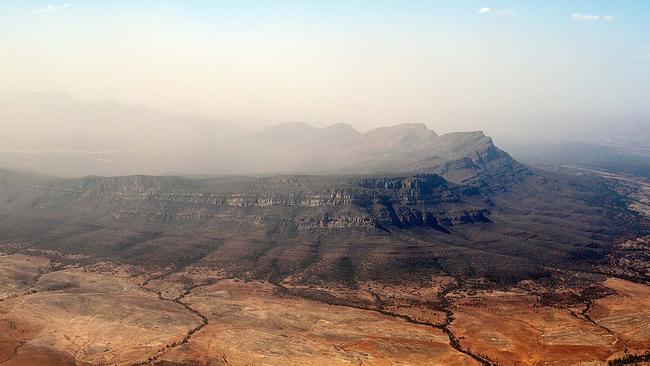Great southern land: Lake Eyre, Wilpena Pound and the Barossa
From the surreal spectacle of Lake Eyre to the tables of the Barossa, South Australia is full of charms.

God spilt His iced latte. That’s what it looks like from up here in the front passenger seat of the small plane as it arcs north-west across Kati Thanda-Lake Eyre, 9500 square kilometres coffee and milk-coloured dirt spread across northern South Australia; this sunset state, this shiraz state, this state of perpetual bliss.
“Does the lake ever end?” I ask Hugh Pottie, our gifted Millennial pilot with a face like Archie Andrews and a mind like David Attenborough. Hugh gazes through his windscreen towards the glowing white horizon. “Eventually,” he says.
We cross a vast stretch of salt and that pure white stuff sparkles like God’s been grinding a mountain-sized diamond 7000ft down there in the dirt. Australia’s largest salt lake. The lowest point below sea level on the mainland, 144km long and 77km wide. The shimmering focal point of Lake Eyre Basin, the most glorious natural drainage system in the world.
Squint and you’re flying into some kind of white heaven. The place is positively hallucinatory. As terrifyingly vast as it is hypnotisingly bare.
FULL LIST: Hot 50 places to stay
We’re on a six-hour Lake Eyre flight with Chinta Tours, a small, family-owned mob offering a range of once-in-a-lifetime fixed or tailored scenic flights in the outback. British nuclear testing sites more your bag? No problem. That’s Maralinga just across the way. Majestic rock formations like the Flinders Ranges more your style? No problem either. Just be sure to ask your pilot about how Chinta Tours came about. Too long a story for these pages but it involves a plucky pioneering pilot named Felicity Brown, Chinta’s co-founder, along with Bob Geldof, a death-defying air race and several women dressed in leopard-print Flintstones outfits.

I’m seeing history in those white twinkling sands. I’m seeing land speed records from the past. I’m seeing 200,000 pelicans roosting here in the floods of 1990. I’m seeing birds flapping their way here from as far afield as Papua New Guinea, somehow evolutionarily attuned to the news that Lake Eyre is filling with rainwater. But it needs no water to impress. In the big dry it’s one vast Jackson Pollock abstract work of wild patterns in the dirt and mud flats. A layer of salt crust 50cm thick that contrasts so brightly against the metallic blue sky that you need your sunglasses to take it in for long periods.
Something intimidating about the size of it. History says the local Aborigines avoided this place and you can understand why. All that perfect nothingness. Stare at it too long and your mind bends, starts to see mirages. Faces in the salt and mud patterns. A snake skin. A rhinoceros head. Wilma Flintstone’s white mini. When explorer Edward John Eyre passed through this way in 1840 he was struck by a place he considered “glittering and brilliant beyond conception”. But there was something disconcerting he found in this place, too. The magnitude of it. He called it a “region of magic” where the landscape was filled with “uncertainty and conjecture”. The place confounds and captivates and eventually casts its spell on you. In truth, that’s what the whole state does to you if you spend enough time in it.
“How ya finding South Australia?” Hugh the pilot asks through the in-flight speaker system. And you put your finger on the little talk button built into your headphones just to say one word.
“Magical.”
There’s a wild witch that can be found most days in Lyndoch, in the hills of the Barossa Valley. A creation of true magic found at the cellar door of Kellermeister Wines, where winemakers Mark and Susanna Pearce are always happy to share the best drop in the world with anyone who asks about it. Susanna smiles and pours a small glass of their Wild Witch Shiraz 2015, which was named nothing less than the best wine in the world at last year’s prestigious London Wine Competition. Then you take your glass of red witchcraft and rest by a table that’s a wine barrel cut in half and then you take a deep breath of fresh southern air and you look out at the patchwork quilt hills of the Barossa and you are done and dusted right there because you know in your heart there never was and there never will be a cure for great Barossa shiraz. This is one witch’s spell that can’t be reversed.
But everybody in this state seems to have a few tricks up their sleeve. In the sprawling Seppeltsfield wine estate on Seppeltsfield Road, cellar door manager David Letch walks you to a vast cellar filled with 100 barrels of their signature port, stretching back to 1920. A barrel for every year. You want to travel back to World War II? Try the 1941. Want to time-warp to the swingin’ Sixties? You can’t go past their ’66 port.
“What year were you born?” David asks.
“1979.”

David pours the sweetest little glass of Donna Summer with a dash of Farrah Fawcett and you hold it up to a ray of sunlight breaking into the cellar and it shimmers in disco golds and ambers and warm fire yellows and right there and then, like magic, you can taste flavours of Little River Band and Leif Garrett with back notes of Simon Townsend’s Wonder World.
And that same road rolls on to the Seppeltsfield Road Distillers, where families and groups of friends and couples are scattered around a shining brass and copper purpose-built gin distillery shaded by towering bushland trees and a southern sun that never seems to go down. Here, owners and quality gin nuts Jon and Nicole Durdin offer tastings of their remarkable and remarkably personal gins, inspired by their Barossa hometown. Jon brings a tray of tasting gins to your table and proceeds to dazzle you with the long, occasionally messy history of London gin-making and the all-too-short history of local gin-making that’s bringing new horizons, and new generations, to the Barossa region.
Forget everything you know about gin drinking. Try Jon and Nicole’s Barossa Dry Gin. Juniper and coriander notes with little firework pops from the pink peppercorns they’ve harvested from the Western Ridge of the Barossa Valley. Try the Savoury Allsorts Gin – star anise fused with thyme, marjoram, borage and gentian – with tonic, a twist of lemon peel and a sprig of fresh thyme. Try the Barossa Shiraz Gin, the couple’s tribute to this hallowed grape region: Western Barossa Shiraz macerated in their house gin, mixing rich shiraz fruit flavours with juniper and orange and cinnamon notes.

All this drinking has suddenly made us hungry so we fill up on some lunch at Ember Pizza in Nuriootpa, the major commercial centre in the Barossa Valley. Try the truffled mushrooms and mozzarella pizza on a garlic base and you’ll know for certain there’s a dark magic swirling around this region.
Dinner has to be in Tanunda, next town on from Nuriootpa. Self-made wonder chef Tuoi Do opened her modern Vietnamese restaurant fermentAsian to Barossa Valley’s savvy foodies in mid-2010; only two years later she was named South Australia’s Chef of the Year by Adelaide’s Advertiser newspaper. All the produce for her restaurant has been grown in a nearby garden created and tended by her parents, Bang and Tinh. Tuoi’s tasting menu is the go-to for the locals. Fresh betel leaves with sticky caramelised Hampshire pork. Salad of coconut-poached chicken breast, cabbage and macadamias. Barossa Hampshire pork belly with ginger and orange sauce. Massaman curry with grilled Mayura Station Wagyu beef and taro. Pure, unadulterated sorcery. As if serving food from her heart and soul wasn’t enough, Tuoi has now opened the doors to a luxury guesthouse, Villa Maria, within easy walking distance of her restaurant.

And after all those long wining and dining roads, the only path left to travel is the one that takes you back into the city towards the most ambitious and dazzling collection of contemporary Aboriginal and Torres Strait Islander art ever assembled. A flagship annual program for the Art Gallery of South Australia, Tarnanthi is a complex, sweeping celebration of art with a powerful, straight-to-the-point mission statement: art that reflects the strength of First Nations cultures across Australia today. Every year the program alternates between a statewide festival of art and a major focus exhibition; its tireless directors spend the entire year leading up to opening night developing works and giving support to artists from every corner of the country. This year’s exhibition opens in October and runs until January, providing an important source of funds for artists and an internationally recognised showcase for their highly individualised artistic expression.
In the Kaurna language of the original people of Adelaide, “tarnanthi” means to emerge, says elder Dr Lewis Yerloburka O’Brien. “Like the sun bringing the first light of day,” O’Brien says. “It suggests new beginnings, opportunities, hope and promise.”
Tarnanthi. That’s not a bad way to describe South Australia in 2020. A place that offers so much for the traveller, so many opportunities, so much promise, with all that magic just waiting to emerge.

Now the sun is falling over Lake Eyre and Hugh Pottie the pilot takes you home via the majestic Flinders Ranges, a serpentine stretch of weathered peaks and rocky gorges like something God made when he banged His fists after dropping His iced latte over Lake Eyre. Hugh flies low over the jewel in the crown of the ranges, Wilpena Pound, and you know there is a kind of magic that emerges only over millennia, and it’s the kind that’s found inside the bowl-shaped Pound’s natural amphitheatre that spans some 80 square kilometres. All the old red sandstone of the ranges is changing colour with the sun. Fire reds and purples and then it’s all so suddenly and overwhelmingly golden.
“Beautiful isn’t it,” Hugh says through the speaker. And you reach again for the talk button on your headphones. But you can’t find anything better than the same worn-out word you’ve been using all flight so you put a word before it to make it sound fresh like the sun bringing the first light of day. “Magical,” you say. “Bloody magical.”
chinta.com.au; agsa.sa.gov.au; southaustralia.com/places-to-go/barossa


To join the conversation, please log in. Don't have an account? Register
Join the conversation, you are commenting as Logout